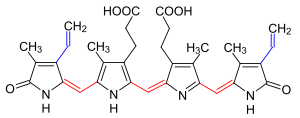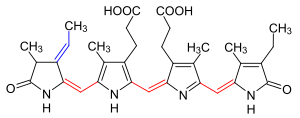Bile pigments

When bile pigments linear be Tetrapyrroles referred that as products in the degradation of porphyrins , particularly the heme stake of hemoglobin , arise. When the porphyrins are broken down, the α-methine bridge between rings A and B of the protoheme is oxidatively cleaved. The cleavage takes place with the help of microsomal hydrolases , which absolutely require the NADPH ferrihemoprotein reductase EC 1.6.2.4 .
The breakdown of hemoglobin takes place in the liver , the pigments are stored in the bile and excreted with the faeces and urine , which creates their typical colors; they are thus also to the Urochromen ( urine pigments ) and Koprochromen ( Fäkalpigmente ).
Classification
Based on the basic body of the bile pigments and the methine groups they contain , the group is divided into "Bilane", "Bilene", "Biladiene" and "Bilatriene". In the overview table the bridging methine groups are shown in red ( - = ), terminal methine groups in blue ( - = ):
| Base body | Number Something groups |
colour | Representative | Structural formula |
|---|---|---|---|---|
| Bilan | 0 | colorless |
Mesobilirubinogen "i-Urobilinogen" |

|
| Sterkobilinogen |

|
|||
|
d-urobilinogen "d-mesobilinogen" |

|
|||
| Bilen | 1 | yellow to orange | Sterkobilin |

|
|
d-urobilin "d-mesobilin" |

|
|||
|
i-Urobilin "i-Mesobilin" |

|
|||
| Biladia | 2 | red | Bilirubin |

|
| Mesobilirubin |

|
|||
|
Phycoerythrobilin, see phycoerythrin |

|
|||
| Bilatria | 3 | green to blue | Biliverdin |

|
|
Phycocyanobilin see phycocyanin |

|
numbering
The following graphic illustrates the numbering of the four different rings (A – D) and the substitutable positions:

Web links
- Nomenclature of Tetrapyrroles (PDF; 1.4 MB) IUPAC.org